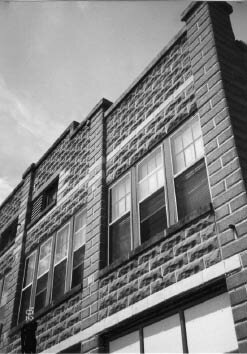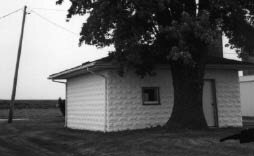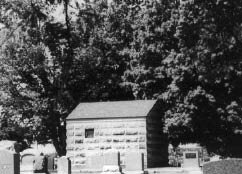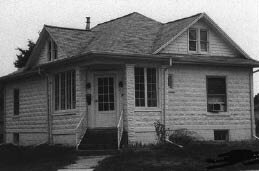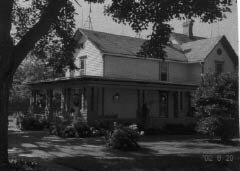
Discover rewarding casino experiences. 
|
The “twin cities” are Sterling and Rock Falls where there are an especially large number of cement built houses, cement that was cast to resemble dressed stone. Rock Falls has many and scattered throughout our area are other homes, barns, garages, commercial buildings and many miscellaneous structures plus as here in Lanark at 121 East Claremont Street (top left), a large wood frame Victorian has an impressive “stone” porch, a later addition. Pictured here, too, is a small building in the Warren Cemetery (bottom right) made of the cement stone in the buff hue, one of the choices. A garage on Rt. 40 just south of Benson Rd. is constructed of the material, that harks back to the 1920’s and which served another type use that will be told in the future! There are houses of ALL sorts and styles built of the material. One in Morrison is awesome in size. Others, small and cozy. The opening years of the use of cement stone was at the turn-of-the-last-century, 1900, some before, some after. Cement in varied form and recipe has been an ingredient in construction for centuries. Abyssinians and the Babylonians used it in their early, early civilizations. The Egyptians used gypsum, an ingredient, in constructing the pyramids. Greeks and Romans at the height of their history, improved upon cement and we witness yet the use of their masonry expertise in their ancient structures. Portland cement is mostly what has been utilized since about 1800 in the United States in the making of concrete. We’ll skip all the chemical processes that make cement/concrete possible. Space doesn’t allow it, nor is our skill in summarizing it!
Burning limestone from a local quarry was how our early settlers achieved the key ingredient in putting up rock foundations, brick walls or even chinking the log residence of old. Lime kilns were scattered throughout the various neighborhoods. Such as the one west of Polo (PDQ Me - 5/21 & 5/28, 2008) and the one formerly west of Lanark at the stone bridge and mill located by it. Quarries were essential in supplying rock and gravel and lime. Little do we realize that importance today. We take cement for granted. Few records exist either to give us a clue as to quantities, price or detail concerning that one-time valuable business. For centuries there were stationery kilns and it wasn’t until 1885 that a patent was applied for, for a rotary kiln, which transformed the trade. A patent had been obtained in Britain in 1877 but it didn’t work out so evolution in the industry occurred in the next decade or two to give the cement/concrete business a boost. Soon many a small town had “block and tile” factories for local usage.
There was one in Lanark, probably rail side in the second block of Carroll St. It may have supplanted the Stover Plow Works which had moved to Freeport. D.W. Dame, the major founder of the town, had purchased it about 1890 to keep it running for the sake of the community but due to ill health soon sold it. Not much is known about it. A short note in the newspaper in 1891 remarked that Levi T. Bray had added a roller grinder at the tile factory to grind unbolted corn meal. Bray was a relative of Dame. Businesses had many facets those days! An old postcard pictures some boys dressed in clothes of the early day sitting in a shed full of what appears to be cement blocks but it’s not identified. From this miscellany we pick up hints that cement products were a regular commodity in most communities. There is, however, more information concerning the manufacture of “cement stone” in the Twin Cities, Sterling and Rock Falls in Whiteside County. A City Directory dated 1911, for instance, lists both “Sterling Concrete Works” at 316 E. Third St. and “Rock Falls Cement Stone Co.” at 408 W. Second, both of which may well have manufactured cement stone for the houses that dot the streets of those towns.
It was several years before 1911 that cement stone came on the scene in the Twin Cities because a neighborhood was developing in Rock Falls of homes; built of that material, developed by T.A. Galt. Its energetic entrepreneur, a characteristic of Galt’s, had grown through decades of his residency (more of that later). An article in a January 1905 “Sterling Standard” announced the winter opening of Galt’s “cement block works” on Third Street, Sterling in the “Wallace Block.” The manufacturing part of the business was performed in the basement of the building where blocks were also “seasoned.” Racks held the blocks to season/dry them, all of several sorts ... “Natural stone” — common cement in plain or pressed face were for foundations and large buildings. “Granite faced” rocks for house and interior work were made from “French cement” imported just for that purpose. A “white-faced” rock also had a granite-like surface. All were available in buff, gray and brown with smooth or pressed face.
A rock faced “natural stone” was manufactured for foundations and first floors of buildings. Four inch blocks were for veneering. Piers for “elaborate porches” of pressed or rock face with hammered edges available if desired. Columns and porch pillars could be made of a four-faced stone as was a buttress stone that could be fit against steps in making porches with a “handsome finish.” There was any number of choices to be used by the home builder wishing to opt for a fashionable house style and a new material that would be permanent with a minimum of upkeep. More than a hundred years later we can see that, yes, the cement stone has barely worn at all. They could be painted or, perhaps, stuccoed but that would take subsequent attention. A show room on street level at Third Street displayed the many types that could be ordered in the coming months of spring. If serious, the customer had to allow a month’s time after ordering for supply enough to construct a house. Orders would be filled in the rotation received.
Months before this article appeared concerning the inventory of the cement stone factory, houses of those materials had already been constructed. There’d been an enticing come-on published for the prospective buyer to learn of the many benefits of building with cement stone AND how even the customer of most modest means could afford such a residence. The much-respected Mr. Galt was again making it possible for folks of the Twin Cities to benefit by remaining in these communities to live and work. He’d initiated such programs in the fifty years he’d been here since his arrival in 1855. —Next Week.
|



